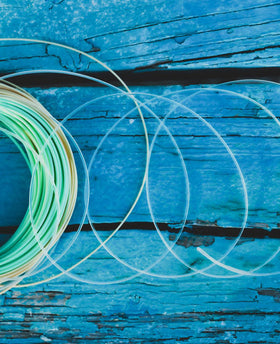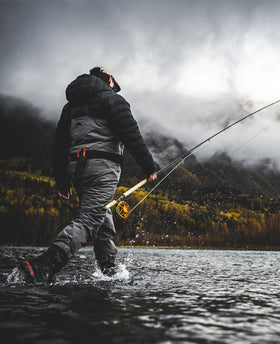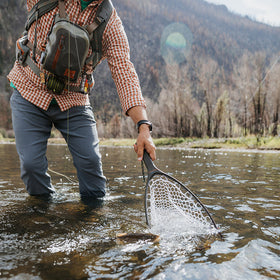
Overcoming the Runoff Blues
It’s that time of the year again, runoff has begun and is only going to get thicker from here. Oftentimes this will bring muddy water that’s hard to fish. These conditions aren’t necessarily favorable for most anglers, but don’t let the runoff stop you from getting out there! There are plenty of opportunities to still go catch some fish. In this blog, we’ll be discussing the options that we have available to us once the runoff gets heavy.
#1: Fish Bright and Big Flies
This really only goes for the anglers who are strongly committed to fishing freestones during runoff. There’s a common misconception that you can’t fish the rivers that are influenced by runoff. Not only is this false, but fishing in dirty water can often lead to great days on the water. Dry fly fishing isn’t much of an option, but if you’re willing to throw a nymph rig or streamer then there’s some options to be had.
If you decide to nymph in runoff, we highly recommend fishing “trashy” nymphs in order to combat the difficult visibility. Flies such as worms, eggs, brighter colored stoneflies, perdigons, head-beaded nymphs, and many more are great options that will help create a visual to the fish. Some rivers will have hatches during runoff, such as salmonflies, but the majority of bugs will not be hatching in these conditions. However, food is getting knocked around left and right in the swollen rivers and will be readily available to the trout. Like I’ve already mentioned, fishing the brighter versions of these flies will help make your flies stand out in the muddy water, as well as differentiate from all the other bugs floating down the river. If you’re going to head out in the muddy water, we highly advise using heavier rods and tippet in order to fight the fish efficiently in the higher water. Oftentimes we go out on the water with a 6wt and 1-3x fluorocarbon tippet.
Streamer fishing can also be a fantastic option during runoff. Generally in dirty water, trout are more willing to chase bigger food options. There’s a few reasons for this, but a big one is the smaller fish have a more difficult time keeping up with the heavy flows and leave them more vulnerable to predation. Your color choice is extremely important this time of year, black, chartreuse, yellow, black/red, and black/red are great color schemes to have your fly visible in the muddy water.
For both nymphing and streamer fishing, it is best to fish the slowest and shallowest water that you can access. The vast majority of fish will be holding in this water so they can expend the least amount of energy possible, while still having access to a ton of food.
#2: Tailwaters
This one seems like a no-brainer so I’ll keep it brief. In case you don’t know, tailwaters are rivers that are controlled and influenced by dam releases from reservoirs. Generally, they receive very little influence from runoff, but may see a bump in flows if reservoir levels increase higher than preferred. Tailwaters generally remain fishable year-round, providing clear water and endless hatches. The water is also considerably colder than freestone rivers because of the dam, so if you’re encountering blistering hot days, the water will generally remain cold enough and not stress the fish. Due to the colder water, tailwater bugs are generally much smaller than their freestone counterparts. Fishing 6x tippet with sz22 flies is not only common, but can often be too big of a fly. In short, tailwaters are a great escape from runoff and offer amazing fishing year-round, just be prepared for the crowds!
#3: Warmwater
This isn’t everyone’s cup of tea and we completely understand. Warmwater fishing typically means fishing in the city, and we all know what that brings. Don’t look past your local waters though, there are some fine gems everywhere. We’ve talked about warmwater fishing many times in our blogs, so I’ll keep this brief as well. Warmwater species include, but are not limited to carp, bass, walleye, wiper, catfish, and sunfish. These species grow big (except for sunfish), fight hard, will eat big offerings, and are minutes from your doorstep. Additionally, if you’re looking to get some practice in for an upcoming saltwater excursion, there’s no better venue than our warmwater. In case you didn’t know, we are huge warmwater fishermen and spend many of our days chasing carp and bass until the higher country opens up!
#4: Stillwater Trout
If you’re looking to catch trophy trout without fighting the crowds on the Taylor, Blue, Frying Pan, or other popular rivers around the state, fishing stillwaters is an amazing option. I’d like to point out that fishing stillwaters, particularly in South Park, won’t completely remove you from the crowds. Spinney Mountain and Antero Reservoirs are popular locations that see a lot of people. The nice part though is that even if there are a lot of people on the water, there’s way more room to move around and find your space. Stillwater fishing can be daunting though, it’s a huge body of water and the fish could be anywhere. Don’t let this scare you away though, these fish are constantly on the move and eat just about everything in their path. If you’re able to find a point, rocky banks, weedlines, and other similar structures you’ll be able to find fish.
Fly choices are pretty straightforward when it comes to stillwaters. If you have a box loaded with chironomids, balanced leeches, and callibaetis nymphs for your indicator fishing, that’s about all you need. Stripping flies can vary, but jigged leeches and standard trout streamers do well. Slowly stripping unweighted chironomids, callibaetis, or damsel nymphs does good as well.
Fishing stillwaters can require specialized gear, but oftentimes the gear you have is all you need. We at GFS personally like to use a 5wt switch rod when fishing indicators to make it easy to bomb our cast out without expending a bunch of energy double hauling. If you don’t want to buy any gear, we often recommend people using a 9-10’ 6 or 7wt rod for all techniques. Standard floating lines work well as a do-all, but if you plan on spending more time stripping flies we recommend an intermediate line at the minimum. When fishing from any type of boat it’s best to have a variety of sinking lines in order to effectively fish different depths.
The next month or two doesn’t have to be a drag, there’s still plenty of options to go catch some fish! We hope this article can help cure your runoff blues and maybe even get you into a new fishing venue. If you have any questions regarding this blog, runoff, or anything else, feel free to contact Xavier via email at xavier@goldenflyshop.com, or call the shop at 303-330-1292. See you next time!






Leave a comment